

Humans (1000 bc) started using iron tools

writing systems (3200 bc)

Humans (3600 bc) started using bronze tools
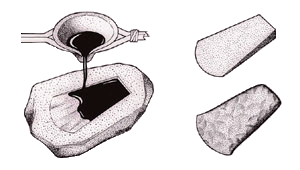
the Copper age (4300 bc)
agriculture (8000 bc)

the Neolithic (8000 bc)

the Mesolithic (9000 bc)
fishing (10,000 bc)
the Holocene epoch (10,000 bc - present)

invention of bow and arrow (20,000 bc)
Dolni Vestonice (26,000 - 20,000 bc)

the last Neanderthal (30,000 bc) died out. MtDNA indicates a split between
Homo sapiens and Neanderthals had occurred more than 500,000 years earlier
Sewing (40.000 bc)
Mining (40.000 bc)

cave paintings (40,000 bc) and engravings on bones
the upper Paleolithic (40,000 - 8000 bc)

Aurignacians (41,000 - 30,000 bc) aka Cro-Magnons were the first modern humans in Europe

first burials (60,000 bc)
the Blombos cave (70,000,000 bc)
the most recent Ice age (70,000 bc) began

the Toba eruption (74,000 bc) was the largest volcanic eruption on Earth in the last 28 million years
and there is some evidence that the human race was reduced to only a few thousand individuals by the event

hunting the mammoth (80,000 bc)
Y-chromosomal Adam (90,000 - 60,000 bc)
the late Pleistocene or the Tarantian (126,000 - 8000 bc)

Mitochondrial Eve (150,000 bc)

Homo sapiens idaltu (160,000 bc) created microlithic tools and weapons
Omo1, Omo2 (Ethiopia, Omo river) (195,000 bc) are the earliest known Homo sapiens
the middle Paleolithic (300,000 - 30,000 bc)

Homo sapiens (500,000 bc) began to hunt animals in a group
Homo heidelbergensis (600,000 bc)
the Brunhes-Matuyama reversal (780,000 bc) was the last magnetic pole reversal
the middle Pleistocene or the Ionian (781,000-126,000 bc)
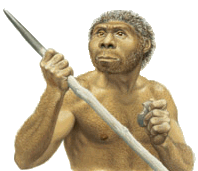
Homo erectus (1,800,000 - 300,000 bc) learned to control fire around 500,000 bc
the early Pleistocene or the Calabrian (1,806,000-781,000 bc)
the Pleistocene (1,806,000 - 8,000 bc) is the first epoch of the Quaternary period
bipedal locomotion (2,000,000 bc)
the Sterkfontein Caves (2,300,000 bc)

Homo habilis (2,400,000 - 1,500,000 bc) used primitive stone tools
Homo rudolfensis (2,400,000 - 1,500,000 bc)
the lower Paleolithic (2,500,000 - 300,000 bc)
the opposable thumb (2,600,000 bc)

Australopithecus africanus (3,000,000 -2,000,000 bc)
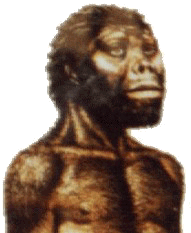
Australopithecus afarensis (3,900,000 - 3,000,000 bc)

Australopithecus anamensis (4,200,000 - 3,900,000 bc) was hunted by Dinofelis
Gigantopithecus (5,000,000 - 100,000 bc)
Human ancestors speciated (5,000,000 bc) from the ancestors of the chimpanzees
the Pliocene epoch (5,300,000 - 1,800,000 bc)
the Strait of Gibraltar opened (5,350,000 bc) allowing the reflooding of the Mediterranean basin

Ardipithecus kadabba (5,800,000 - 5,200,000 bc), Ardipithecus ramidus (5,000,000 - 4,400,000 bc)
the Messinian Event (5,900,000 bc)
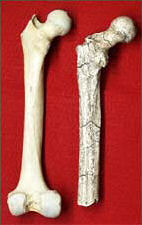
Orrorin tugenensis (6,000,000 bc)
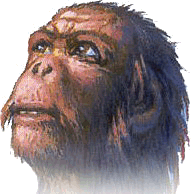
Sahelanthropus tchadensis (7,000,000 - 6,000,000 bc)
Human ancestors speciated (10,000,000 bc) from the ancestors of the gorillas
Pierolapithecus catalaunicus (13,000,000 bc)
Human ancestors (13,000,000 bc) speciated from the ancestors of the orangutan

Ramapithecus wickeri (14,000,000 - 10,000,000 bc) used bones as tools
Apes from Africa (15,000,000 bc) migrated to Eurasia to become gibbons (lesser apes)
and orangutans. Human ancestors speciated from the ancestors of the gibbon
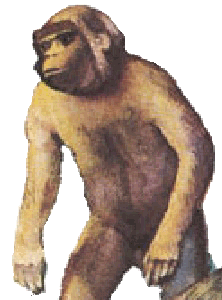
Dryopithecines (23,000,000 bc) were the common ancestors of both apes and humans
the Miocene epoch (23,000,000 - 5,300,000 bc)
Catarrhini (Old World Primates) split into 2 superfamilies (25,000,000 bc) Old world monkeys (Cercopithecoidea)
and Hominoids. The Old world monkey does not have a prehensile tail (e.g. Baboon); some do not have tails at all.
All hominoids have no tails (e.g. the lesser apes, great apes and hominids)
Anthropoids (30,000,000 bc) split into the infraorders Platyrrhini (New World Monkeys) and Catarrhini
(Old World Primates). New World Monkeys have prehensile tails and migrated to South America. Catarrhines
stayed in Africa as the two continents drifted apart. One ancestor of catarrhines might be Aegyptopithecus

Aegyptopithecus zeuxis (33,000,000 bc) Dawn Ape
the Alps arose as a result of the pressure exerted on sediments of the Tethys Ocean basin as its Mesozoic
and early Cenozoic strata were pushed against the stable Eurasian landmass by the northward-moving African
landmass. Most of this occurred during the Oligocene and Miocene epochs
the Oligocene epoch (34,000,000 - 23,000,000 bc)
Biretia fayumensis and Biretia megalopsis (37,000,000 bc) were early anthropoids living in the Egyptian desert
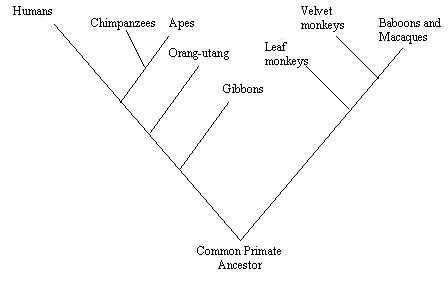
Primates diverged (40,000,000 bc) into the suborders Prosimians (a primitive monkey) and Anthropoids,
the latter is diurnal and herbivorous. Examples of today's prosimians are tarsiers, lemurs, lorises
Algeripithecus (45,000,000 bc)
the Himalayas formed when the north-moving Indo-Australian Plate, collided with the Eurasian Plate
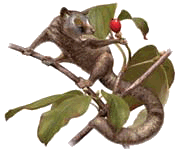
Carpolestes simpsoni (55,000,000 bc) is an extinct species of Plesiadapiformes,
which are the earliest primate-like mammals appearing in the fossil record
Teilhardina asiatica (55,000,000 bc)
the Eocene epoch (56,000,000 - 34,000,000 bc)
Altiatlasius (57,000,000 bc)
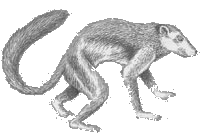
Plesiadapis (60,000,000 bc) is one of the oldest known primate-like mammal species

Purgatorius (65,000,000 bc) is believed to be the earliest example of a proto-primate

the Cretaceous-Tertiary extinction event (sixth extinction event) (65,000,000 bc) wiped out about half of all animal species
including all non-avian dinosaurs, probably because of a cooling of the climate precipitated by the giant impact of a meteor
the Paleocene (65,000,000 - 56,000,000 bc) is the first epoch of the Palaeogene Period in the modern Cenozoic era
Eomaia scansoria (125,000,000 bc) Ancient Mother